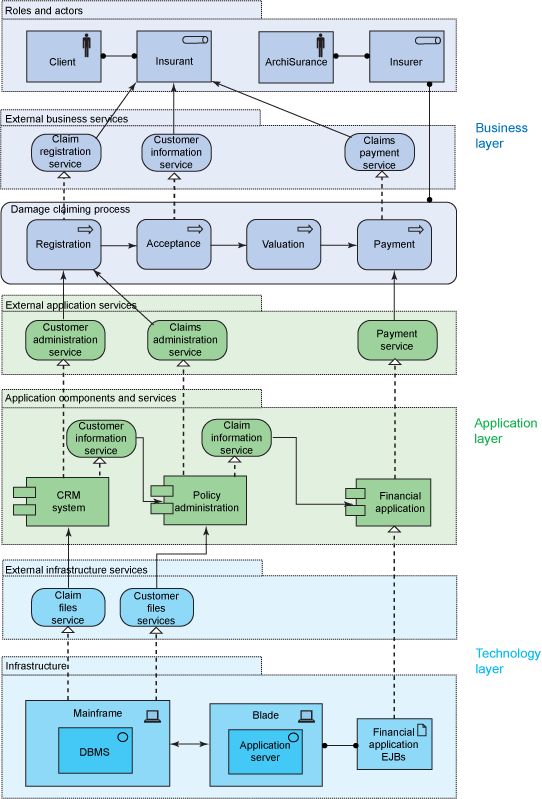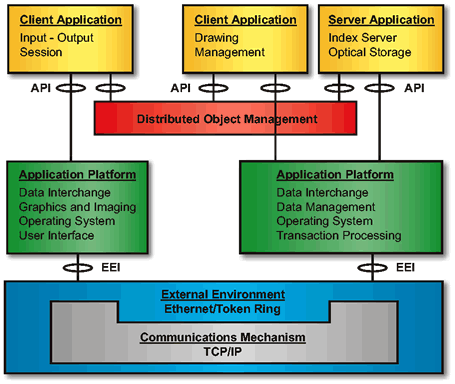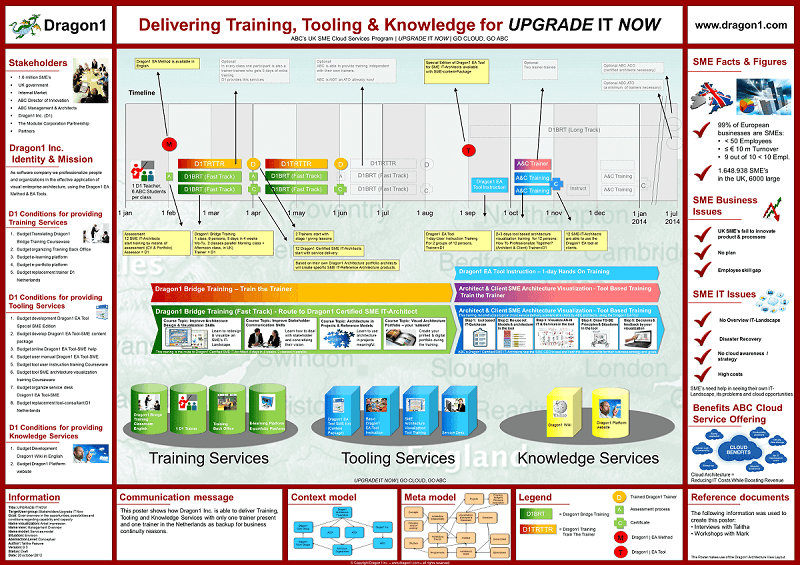It is all about getting your architecture products used
So you have finished your basic enterprise architecture training course like TOGAF Definition 9.1 or ArchiMate Definition 2.1 and got certified maybe even in both of them. Now, the phase starts with applying your knowledge in practice.
Too often, architects then face two problems. Problem 1: You have no time to carry out the architecture process prescribed by TOGAF. The second problem is that people don’t understand your architecture models. They find them too technical and doubt they are the target audience for these models.
These two problems cause fewer architecture products to be asked from you as an architect, and your architecture products certainly won’t be used to support strategic decision-making.
Unused architecture products are a waste of time and money.
This does not have to be the case!

Figure 1. Example of a typical useful ArchiMate diagram often created by architects, but not understandable for CxOs or Management and therefore not used to support their decision-making.

Figure 2. Example of a TOGAF diagram showing a distributed computing architecture.
Visualize and Communicate Architecture Products for their purpose, aligned to your Stakeholders
Not everyone knows anything. Also, not everyone is interested in everything. These are two important things to remember when visualizing and communicating an architecture product to your target audience.
So when you create an application landscape diagram with schematic symbols containing technical information, your CIO hardly knows how to use it to support his decisions to align the application landscape with the new business strategy.
>> Keep your stakeholders, their interests and their
prior knowledge in mind, when creating visualizations
If you create an IT infrastructure landscape with many symbols looking the same or having no meaning for the viewer, many IT managers do not know how to use it to support their decisions to standardize and lower costs in the IT infrastructure landscape.
So you need to visualize the application landscape and IT infrastructure landscape for its situational purpose of supporting decision-making by CxOs and Management. If you do this successfully, your stakeholders will love and use your architecture products.
How Application Landscapes and IT Infrastructure Landscapes enable and support Decision Making
When looking at your job profile, you will see what professional products your stakeholders request, directly and indirectly. For many IT architects, this means they really should start producing the application landscape, part of application architecture, and the IT infrastructure landscape, part of the IT infrastructure architecture. And keeping them updated.
So now you know what to do but still need time to do it and find out why people want to use it? Why is it essential to them?
>> What is the use of creating landscapes
for owner/clients and stakeholder?
Practice shows that large A0-sized overview posters of application and IT infrastructure landscapes enable and support decision-making when understandable and pretty complete for stakeholders. Knowing this, you might take the next step of inspiring the owner/client of the company and the company’s stakeholders by showing them example landscapes and telling them you could create these for them so they can get ongoing with a decision that is already waiting for months or years to be taken, blocking the execution of strategy or realizing goals.

Figure 3. Example of a Scenario Planning Roadmap for new Services and Training aimed at CxOs to show when consultants are trained in the new services of the company.
You may get an assignment from your owner/client and his stakeholders. With that, you suddenly have time and budget to create the application landscape and IT infrastructure landscape.
Last but not least, check out examples of visualizations your stakeholders use to make decisions. Analyze the information on these visualizations, such as what symbols are used to show functions, attributes, patterns, relationships with strategy and goals, etc. And verify what is NOT shown (maybe certain technical information).
If you do all this, you may be well on your way to creating architecture visualizations for strategic decision-making.
Bridge the gap between Strategy and Programs with Enterprise Architecture Visualizations from Dragon1
Next to TOGAF as Architecture Framework and ArchiMate as EA Modeling Language, there is Dragon1 as open EA Method and EA Framework.
Dragon1 EA Method contains an innovative way of thinking, way of working, way of representing, and way of working with Enterprise Architecture at a strategic decision-making level.
In the Dragon1 open EA Method the Architecture definition states that architecture is a total concept [def.] (i.e., a coherent whole of cooperating concepts). Architects are seen as the designers of these total concepts and supervisors of the realization of structures with the total concept applied to them. This means that you, as an architect, should create visualizations of the stakeholders' requirements, architecture principles, and concept designs and have the owner/client and stakeholder approve them so the designs can be used and realized in projects.
>> Did you know that The Open Group recognized Dragon1
as one of the methods by which you can certify as an architect?
In Dragon1, architecture is positioned as a total concept and, with that, as an enabler of controlled execution of fundamental strategic change (risks are managed). In the framework, in Figure 4, you’ll see how enterprise architecture translates strategy into blueprints, landscapes, and roadmaps and how projects use these as a guiding framework for realizing solutions.

Figure 4. Dragon1 Enterprise Performance Framework.
You can use all the knowledge you gained during the TOGAF and ArchiMate training to create architecture products compliant with these standards. Next, you’ll create blueprints, landscapes, and a roadmap based on Dragon1 to visualize the architecture products to the right target audience. This will allow the owner/client and stakeholders to approve your architecture products and use them in projects.
What more do you want as an architect? Maybe to play a significant role in the project, supervising the realization to minimize the architectural deviations.
Dragon1 as EA method will keep a close look on the TOGAF next version and ArchiMate next version and make sure that you always, as an architect, will benefit from using Dragon1 EA Method in addition to TOGAF 9.1 and ArchiMate 2.1.
As I have started this blog, I can repeat: Enterprise Architecture does not end with TOGAF 9.1 and ArchiMate 2.1.
Previous Blogs
Read also my recent blogs on:
Dragon1 EA Method - Training Curriculum
Suppose you want to learn about Visual Enterprise Architecture the Dragon1 way. You can enroll in three training courses. Dragon1 EA Method Training Curriculum provides a level 1 certification training course with Dragon1 Foundation and a level 2 certification training course with Dragon1 Certified.
For more information go to Dragon1 Foundation Training (Level 1 certification) or Dragon1 Practitioner (Level 2 certification)
Dragon1 EA Method - Bridge Training
For architects with prior knowledge of working with Enterprise Architecture or even certification in TOGAF and ArchiMate, the Dragon1 EA Method Training Curriculum provides EA bridge training.
The Dragon1 Bridge Training is the optimal training course that offers the participant his unique training course program, skipping known theory and paying more attention to creating architecture visualizations.
For more information go to the Dragon1 Bridge Training